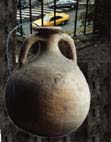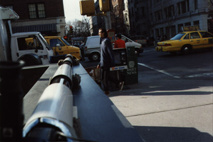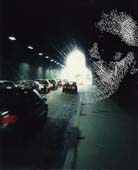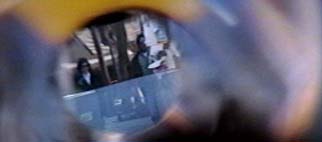
So how did we get into this?



 In Rome in 1992 Sam and I were making a sound installation in support of Peter Erskine's solar spectrum work "Secrets of the Sun". The amazingly rich visual aesthetic of the Trajan's Forum site with its famous proto-gothic arched Aula by the architect Apollodoris was to our ears completely over-ridden by the bombardment of the noise of Rome traffic passing by on the busy via Fourth of November. It had now become a band shell for amplifying Fiats and Vespas. Rather than escalate and add a still louder sound of our own, we decided to use this ever present 20th century sound as our basic material and seek a method of transforming it.
In Rome in 1992 Sam and I were making a sound installation in support of Peter Erskine's solar spectrum work "Secrets of the Sun". The amazingly rich visual aesthetic of the Trajan's Forum site with its famous proto-gothic arched Aula by the architect Apollodoris was to our ears completely over-ridden by the bombardment of the noise of Rome traffic passing by on the busy via Fourth of November. It had now become a band shell for amplifying Fiats and Vespas. Rather than escalate and add a still louder sound of our own, we decided to use this ever present 20th century sound as our basic material and seek a method of transforming it.
An exploration of the available sound resources at the site included dropping a stereo mic into a Roman Amphora. It sounded as if all the bells of Rome were ringing inside but on withdrawing the mic it was merely traffic noise. This clay vessel from slave-powered Rome had become in our fossil-fueled century, an acoustically activated synthesizer, trapping and resonating the tones of the traffic into a complex pool of shifting harmonics. Low tones of busses would activate a deep fundamental, passing vespas would make high overtone chords, emergency sirens became solo melodic voices when heard within the echoing clay confines. We secured permission from the archeologist in charge and then chose for our use 4 out of about 250 amphorae, each of which had a different character to its overtone series.
So we used the traffic sound resonating inside the amphorae, filtered it amplified it and projected it back real-time on site, a musically tuned version of the urban noise. We chose as our focal point the archway over the old roman road which used to be a main entrance to the forum. There we hung a single planet speaker of ceramic, powered by solar panels, and its focused beam of tuned traffic resonance played across the curved surfaces of the old roman architecture and transformed the sonic ambiance in a harmonic way. What we could not have foreseen is that about that exact time an atmosphere of calm descended on the international crew of workers who up till that point had been arguing avidly in many languages.

 After working in Rome we wanted to explore the possibilities of another richly noisy city, New York. Challenged by John Hanhardt of the Whitney Museum to find the metaphor for Amphora in America we decided to study New York's transportation hub, Grand Central Station. We became obsessed with the theory that there was a standing wave produced by trains, traffic, ventilation fans, electrical hums lighting, air conditioning which was producing a harmonic series and that the terminal itself with its giant vaulted ceiling was like the amphora in Rome , resonating.
After working in Rome we wanted to explore the possibilities of another richly noisy city, New York. Challenged by John Hanhardt of the Whitney Museum to find the metaphor for Amphora in America we decided to study New York's transportation hub, Grand Central Station. We became obsessed with the theory that there was a standing wave produced by trains, traffic, ventilation fans, electrical hums lighting, air conditioning which was producing a harmonic series and that the terminal itself with its giant vaulted ceiling was like the amphora in Rome , resonating.
Why could we not hear this? The theory was that a single set of ears was unable to hear this chord- the scale was just too large to perceive. The waves were too long and the physical distances between harmonics too great. So Sam and I synchronized two dat recorders in the center of the hall, then separated in space but not in time. I walked the path of the commuters going to the trains and back while Sam stayed in the center of the terminal. Later when we synchronized these recording and listened as if to four ears and two perspectives at once the resonating chord immediately appeared. This chord is comprised of train motors at the fundamental resonated down the long underground tubes joining the main terminal, air- conditioning at the fifth, fans at the octave, and a sub harmonic produced by the giant ventilation fans on the roof. Remove either of the two channels and it disappeared again. GCT is like a huge resonating instrument which is plays a shifting harmonic structure that is an audio read-out of NYC's transportation hub.

 As our interest in modifying ambient urban sounds developed we were working on an idea as yet unrealized to transform four resonances of Salzburg into a real-time installation. Doppler had done much work in Salzburg. This influenced our choice to make a binaural recording of passing rush hour traffic in the Sigmund Tor, a 17th century tunnel through the Monchsberg. Later we removed the cars and trucks with computer filtering leaving only the resonance of the tunnel and its doppler shifting melody. The site we were studying, Furtwengler Park, is over an underground river, the Almkanal, which we discovered by listening to a G# and a C# tone coming up from the lawn. The hidden river was connected to the drain system of the park, and these drains were functioning as resonating tubes making the basis of a C# major drone. We felt that we were discovering hidden inner voices of the city caused by architecture, infra-structure, traffic and water.
As our interest in modifying ambient urban sounds developed we were working on an idea as yet unrealized to transform four resonances of Salzburg into a real-time installation. Doppler had done much work in Salzburg. This influenced our choice to make a binaural recording of passing rush hour traffic in the Sigmund Tor, a 17th century tunnel through the Monchsberg. Later we removed the cars and trucks with computer filtering leaving only the resonance of the tunnel and its doppler shifting melody. The site we were studying, Furtwengler Park, is over an underground river, the Almkanal, which we discovered by listening to a G# and a C# tone coming up from the lawn. The hidden river was connected to the drain system of the park, and these drains were functioning as resonating tubes making the basis of a C# major drone. We felt that we were discovering hidden inner voices of the city caused by architecture, infra-structure, traffic and water.

 In 1993 in Berlin we were once again making a sound installation in support of Peter Erskin's Secrets of the Sun. This time the site was the proud 1956 parabolic structure donated by the Americans in the height of the cold war paranoia. The Kongresshalle is located on John Foster Dulles allee due west of the Reichstag and looks like nothing so much as an Eagles Beak taking a bite out of Berlin. First we listened to the sounds existing in the area; intense traffic, bell tower, fountains, picnics, people, cars, busses, i.e.: intense but normal large city noise penetrating the park-like visual look and amplified and reflected by the colossal post-war cement monument.
In 1993 in Berlin we were once again making a sound installation in support of Peter Erskin's Secrets of the Sun. This time the site was the proud 1956 parabolic structure donated by the Americans in the height of the cold war paranoia. The Kongresshalle is located on John Foster Dulles allee due west of the Reichstag and looks like nothing so much as an Eagles Beak taking a bite out of Berlin. First we listened to the sounds existing in the area; intense traffic, bell tower, fountains, picnics, people, cars, busses, i.e.: intense but normal large city noise penetrating the park-like visual look and amplified and reflected by the colossal post-war cement monument.
We chose to use a resonating tuning tube of 4 meters at the bus stop located at the main entrance. The tube's interior reinforcing a clear overtone series and reducing all incoming sounds to those possible intervals. Our rhythmic structure was the arrival and departure of busses which activated the tubes fundamental and first octave overtone every 5-10 minutes. A tambura like drone was provided by the fountain in the reflecting pool near bye. Occasional interludes of people coming and going, or waiting for the buss provided melodic interest as their voices and footsteps were scanned and distributed on the upper partials . We tuned the position of the microphone in the tube to the flat 7th giving the whole a sort of blues scale.
For the position of the speaker which would re-introduce this tuned resonance to the site we considered for several days. Finally we chose to use a planet speaker on the cement floor of the plaza pointed up at the parabolic cement roof. Since the beam of sound it produces is very directional you could stand right next to it with the speaker almost at your feet and the sound still seemed to emanate from the arched roof above, its first reflection. There with very little power from the amps we could use the parabolic architecture to amplify the sound. Walking around the site and hearing this beam of tuned resonance coupled with the architecture changed the perception of the site making the dominating shape of the parabolic roof seem to float like a wing.
This form of composing with resonance, speakers, architecture and live input of a city as a sound source to generate all the sounds has one main benefit. It continually refreshes itself. It is never the same. As an interface it is always changing in response to its sound environment- with the traffic, visitors, season, weather and with the time of day. It transforms into a perceivable information the interplay that is going on already.

So we made a portable tuning tube of 3 sections of HPI plastic which had the interesting visual property of being like a black mirror on the inside. We added a video camera to document the sources of these extraordinary sounds. Plus we had heard that seeing is believing.
We took the same system to 3 varied locations; a waterfall, a pedestrian overpass at the World Trade Center in NYC, and rush hour on the street outside the Whitney Museum in on Madison and 75th. The results were outstanding visually as well as sonically. At the Whitney we were absorbed by hearing and seeing the rich melodic content of urban sonics and did not realize till later that we had recorded all through a violent hostage situation which had developed at a Jewelry store on the next block. The gunshots sirens and Police warnings can clearly be heard on the recordings. (Hostage Variations on our recent CD RESONANCE, O+A 95)
Around this same time Sam had been experiments with digital filters from IRCAM institute called GRM tools were added as a tool bank for exploring these city resonances and added a clarity and detail of refinement to the work. The sounds now passed from the tuning tube which generated an overtone series to the computer which could be used as a window of exploration into the hearing perception, allowing an almost symphonic range of voices buried in the city ambiance to be heard.